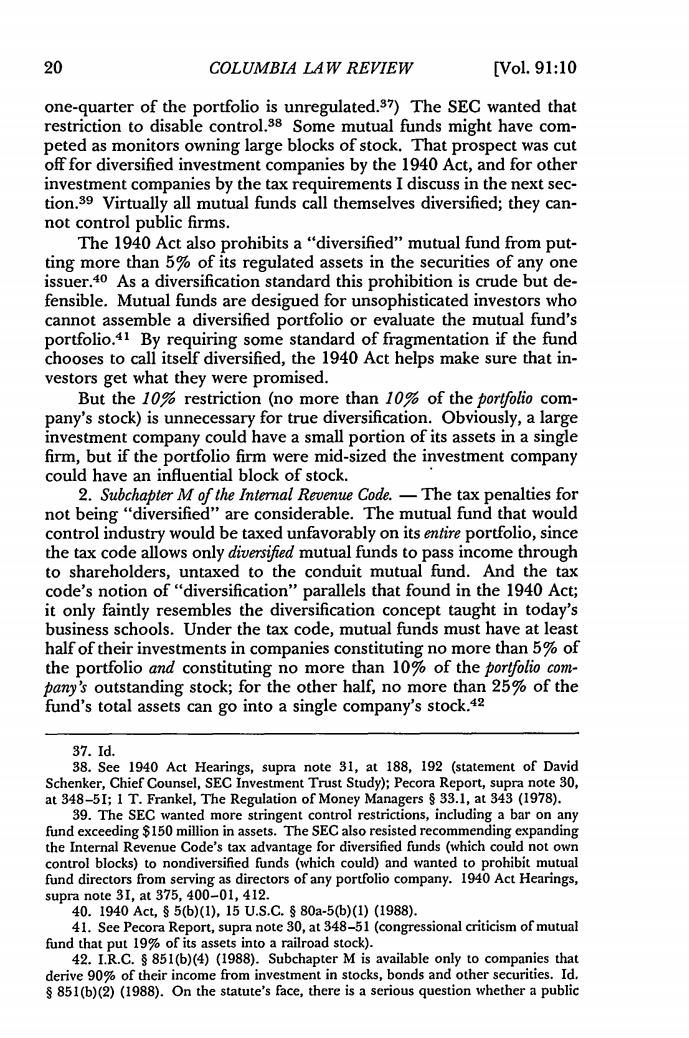正在加载图片...

20 COLUMBIA LAW REVIEW [vol.91:10 one-quarter of the portfolio is unregulated.37)The SEC wanted that restriction to disable control.38 Some mutual funds might have com- peted as monitors owning large blocks of stock.That prospect was cut off for diversified investment companies by the 1940 Act,and for other investn nent co anies by the tax tion.Virtua ements I discuss in the next se all mutual funds call themselves diversified;they can not control public firms. The 1940 Act also prohibits a"diversified"mutual fund from put- ting more than 5%of its regulated assets in the securities of any one r.40 As a div ersification sta ndard this prohibiti ion is crude but de 1 funds are d esig or unsophisticated investors who cannot assemble a diversified portfolio or evaluate the mutual fund's portfolio.41 By requiring some standard of fragmentation if the fund chooses to call itself diversified,the 1940 Act helps make sure that in- vestors get what they were promised. But the 10%restriction (no more than 10%of the porlfolio com- pany's stock)is unnecessary for true diversification.Obviously,a large investment company could have a small portion of its assets in a single firm,but if the portfolio firm were mid-sized the investment company could have an infuential block of stock e Code.-The tax enalties for not being are considerable. The mutual fund t t would control industry would be taxed unfavorably on its entire portfolio,since the tax code allows only diversified mutual funds to pass income through to shareholders,untaxed to the conduit mutual fund.And the tax notion of"diversification' arallels that found in the 1940 Act; it only fain tly re e diver sification c ncept taught in today's business schools.Under the tax code,mutual funds must have at least half of their investments in companies constituting no more than 5%of the portfolio and constituting no more than 10%of the portfolio com- bany's outstanding stock;for the other half,no more than 25%of the fund's total assets can go i to a si company's stock.42 80o5cCywS0 ee 1940 Act Hearir note 31.at 188.192 (statement of Davic at 348-5I;1 T.Frankel,The Regulation of Money Ma fund9.The SE more str restric P88150 na bar on any Code's or di control blocks)to nondiversified funds (which could)and wanted to prohibit mutual fund directors from serving as directors of any portfolio company.1940 Act Hearings, )(). 41 see pe ote30,at348-51c fund that uteintorad stoc). 42.I.R.C.$851(b)(4)(1988).Subchapter M is available only to companies that bonds and othe ne statute's face,there is a serious question wCOLUMBIA LAW REVIEW one-quarter of the portfolio is unregulated.37) The SEC wanted that restriction to disable control.38 Some mutual funds might have competed as monitors owning large blocks of stock. That prospect was cut off for diversified investment companies by the 1940 Act, and for other investment companies by the tax requirements I discuss in the next section.39 Virtually all mutual funds call themselves diversified; they cannot control public firms. The 1940 Act also prohibits a "diversified" mutual fund from putting more than 5%o of its regulated assets in the securities of any one issuer.40 As a diversification standard this prohibition is crude but defensible. Mutual funds are designed for unsophisticated investors who cannot assemble a diversified portfolio or evaluate the mutual fund's portfolio.41 By requiring some standard of fragmentation if the fund chooses to call itself diversified, the 1940 Act helps make sure that investors get what they were promised. But the 1Ore restriction (no more than 1017/ of the portfolio company's stock) is unnecessary for true diversification. Obviously, a large investment company could have a small portion of its assets in a single firm, but if the portfolio firm were mid-sized the investment company could have an influential block of stock. 2. Subchapter M of the Internal Revenue Code. - The tax penalties for not being "diversified" are considerable. The mutual fund that would control industry would be taxed unfavorably on its entire portfolio, since the tax code allows only diversified mutual funds to pass income through to shareholders, untaxed to the conduit mutual fund. And the tax code's notion of "diversification" parallels that found in the 1940 Act; it only faintly resembles the diversification concept taught in today's business schools. Under the tax code, mutual funds must have at least half of their investments in companies constituting no more than 5% of the portfolio and constituting no more than 10%o of the portfolio company's outstanding stock; for the other half, no more than 25%o of the fund's total assets can go into a single company's stock.42 37. Id. 38. See 1940 Act Hearings, supra note 31, at 188, 192 (statement of David Schenker, Chief Counsel, SEC Investment Trust Study); Pecora Report, supra note 30, at 348-51; 1 T. Frankel, The Regulation of Money Managers § 33.1, at 343 (1978). 39. The SEC wanted more stringent control restrictions, including a bar on any fund exceeding $150 million in assets. The SEC also resisted recommending expanding the Internal Revenue Code's tax advantage for diversified funds (which could not own control blocks) to nondiversified funds (which could) and wanted to prohibit mutual fund directors from serving as directors of any portfolio company. 1940 Act Hearings, supra note 31, at 375, 400-01, 412. 40. 1940 Act, § 5(b)(1), 15 U.S.C. § 80a-5(b)(1) (1988). 41. See Pecora Report, supra note 30, at 348-51 (congressional criticism of mutual fund that put 19% of its assets into a railroad stock). 42. I.R.C. § 851(b)(4) (1988). Subchapter M is available only to companies that derive 90% of their income from investment in stocks, bonds and other securities. Id. § 851(b)(2) (1988). On the statute's face, there is a serious question whether a public [Vol. 91:10